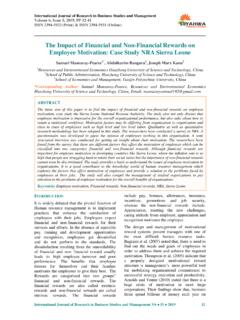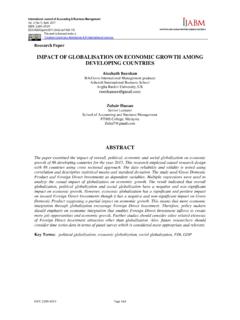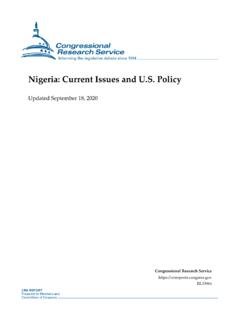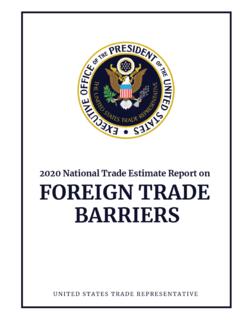Transcription of The Impact of Savings in Economic Growth: An ... - IJRBSM
1 International Journal of Research in Business Studies and Management Volume 2, Issue 9, September 2015, PP 10-21 ISSN 2394-5923 (Print) & ISSN 2394-5931 (Online) *Address for correspondence: International Journal of Research in Business Studies and Management V2 I9 September 2015 10 The Impact of Savings in Economic Growth: An Empirical Study Based on Botswana Dhanya Jagadeesh Department of Entrepreneurship, BAISAGO University, Gaborone, Botswana ABSTRACT The purpose of this paper is to investigate the role of Savings in Economic growth in Botswana. Botswana is one of the most successful resource-rich countries in the world. The study applied the Harrod Domar growth model to the Economy of Botswana. In this study test is based on Auto Regressive Distributed Lagged (ARDL) model by Pesaran, Shin and Smith (1999) to check the existence of a long run relationship between Gross Domestic Product and Gross Domestic Savings in Botswana.
2 This study further used DOLS approach in order to identify dynamic long run co integration between GDP and its independent variables. The study tested the stationarity and co integration of Botswana s time series data for the period of 1980 to 2013. The test found out that there is significant relationship between Savings and Economic growth and the study supported Harrod Domar growth Model. Policies are suggested to accelerate Economic growth in the country. Keywords: Savings , Economic Growth, Botswana, ARDL, DOLS, & Harrod Domar. INTRODUCTION The Economic growth of a country can be referred to as the economy s capacity to increase the productivity of services and goods in comparison with previous time period (Finance map of world, 2013). Savings has long been considered as an engine for Economic growth. A study has been conducted in China (Chow, 1993) evidenced that countries that had made sustained accumulation of fixed capital have been able to achieve higher and sustained Economic growth and development than other countries.
3 The accumulation of fixed capital can only be possible through sufficient Savings . Developing countries are always constrained by inadequate Savings and investment, for instance Economic development in Sub-Saharan Africa has been constrained by inadequate Savings and investment, (Wollasa. , 2011), This is one of the reasons behind Africa is still known as the world's poorest continent (Gimbari, June 2, 2002) Savings creates capital formation and it further leads to technical innovation and progress which helps with the economies of large-scale production and increases specialization, which helps to accelerate the productivity of labour, it further resulting increased GDP. Thus Savings leads to fuller utilization of available scarce resources in an efficient way, increase in the size of national output, income and employment, thereby solving the problems of inflation, unemployment and balance of payment, poverty, inequality; and making the economy free from the burden of foreign debt and leads to state of better welfare.
4 The vicious circles of poverty in developing countries can also be broken through sufficient Savings , and it is the main key to Economic development as well. Additionally, it is notable that the slow rate of development in third world countries are usually attributed to the low levels of national Savings , that constraint their capacity to invest in capital formation. This leads to lower level of Economic growth and development than other countries that contribute enough Savings . So saving is usually considered as the main source of Economic growth. Previous studies especially Mrs Dhanya Jagadeesh The Impact of Savings on Economic Growth: An Empirical Study Based on Botswana 11 International Journal of Research in Business Studies and Management V2 I9 September 2015 Loayaza (2002) considered that on average Sub-Saharan Africa saves less than 15 percent, while East Asia saves more than 30 percent of Gross National Disposable Income (GNDI).
5 In this study we use Harrod Domar model to test the theory in the economy of Botswana. Harrold Domar model is suitable model to be used to show such relationship because the theory describes the mechanism by which more Savings leads to more Economic growth because Savings leads to investment and it leads to capital formation, which generates Economic growth, so Savings is most important factor for economy to grow and develop. Roy Harrod (1939) and Evsey Domar ( 1946) suggested that if a developing country wants to achieve Economic growth, the government in that country need to encourage Savings . The framework for Economic growth given by Harrod and Domar, has been an important influence to government policies in some other developing countries. There for the main objective of this paper is to examine whether there is any significant relationship between Savings and Economic growth in Botswana.
6 The model shows mathematically that growth is directly related to Savings . Let Y represent output, which equals income, s is the Savings rate, and. k stands for capital output ratio, and by using these variables we can construct the following model of Economic growth. G = ( Y/Y) = (s / k) (1) )2(// ksYY Increasing the Savings rate will increase the growth rate of output; these are the means to achieve growth in the Harrod Domar model. Its implications were that capital formation depends on the level of Savings , which generates Economic growth. Less economically developed countries do not have sufficient incomes to enable high rates of saving, and therefore accumulation of the capital stock through investment is low. The model implies that Economic growth depends on policies to increase investment, by increasing saving, and using that investment more efficiently through technological advances.
7 Objective of the Study 1. To investigate the significant relationship between Savings and growth in Botswana 2. To test the Harrold- Domar model in the economy of Botswana Background of Botswana Economy Botswana is one of the countries in Sub-Saharan Africa and it is landlocked country situated in the Center of southern Africa, sharing borders with South Africa, Namibia, Zimbabwe and Zambia. With a population of around 2 million, Botswana was one of the poorest countries in the world at the time of independence in 1966 (Second Common Country Assessment for Botswana, 2007). It has grown rapidly over the past forty years, and has been transformed from a low-income to an upper-middle income country within three decades. Diamonds has been the basis of Botswana s economy, which has driven very high rates of Economic growth. Gross Domestic Product per capita more than doubled, at current prices, from 3203 US dollars (USD) in 2000 to USD 6877 in 2008 but slipped to USD 5822 in 2009, reflecting the Impact of the global slump on demand for diamonds and other minerals again 2012 it increased to 8680 US dollars (African Economic Outlook, 2011).
8 Despite the impressive progress in per capita income at current prices, rates of poverty ( % in 2003), unemployment ( % in 2010), inflation ( % in 2012 )and inequality is still high (Gini index 63 in 1993) in Botswana. Income distribution is very unequal, with the richest 20% of households Mrs Dhanya Jagadeesh The Impact of Savings on Economic Growth: An Empirical Study Based on Botswana International Journal of Research in Business Studies and Management V2 I9 September 2015 12 earning around 70% of total household income (Jefferis, 2011). Growth performance of Botswana heavily depends on the diamond sector. Botswana s over dependence on diamond exports is a challenge for sustainable Economic growth. In addition to these challenges Botswana s growth rate has also been deteriorating over a long period of time. Table1.
9 Source: World Bank, World Trade Indicators 2013 Although in 1988 and 1989 GDS was very high, compared to the following years it was 50 % in 1988 and 49 % in 1989, after that it started to decline especially during the period of 2008 to 2013. For example the Gross Domestic Savings as a percentage of GDP was 29% in 2008, which became 20% in 2009. During the same period GDP also deteriorated from 3% in 2008 to -7 % in 2009 and all this time capital formation rate was also very low and it has fluctuated quiet sharply from year to year so it is clear that the deterioration in Savings affects capital formation and it caused to low level of GDP also. Table2. YEAR GDP GDS 2005 4,55664575 44,492096 2006 7,95953106 44,079055 2007 8,68234066 44,719847 2008 3,90146671 29,628547 2009 -7,84100187 20,533088 2010 8,59413556 24,944424 2011 31,461101 2012 4,31416573 23,247880 2013 5,82703081 29,092863 Source: World Bank, World Trade Indicators 2013 Relevance of the Study Botswana has been chosen as a case study for this paper.
10 Despite its excellent Economic performance, Botswana faces a number of serious development challenges of high rates of unemployment and high levels of poverty. of the population (2003) lives below Poverty line (Central Intelligence Mrs Dhanya Jagadeesh The Impact of Savings on Economic Growth: An Empirical Study Based on Botswana 13 International Journal of Research in Business Studies and Management V2 I9 September 2015 Agency, 2013). Unemployment was estimated at 0 % in 2010 and it was only % in 2006 and it is closely connected to poverty. Inflation in 2012 is slightly higher than 2010, According to the database with World Bank it was % in 2010, and % in 2012. In addition to these major challenges Economic growth has also gradually trended downwards and the capital formation rate has dropped from 28% in 1998 to 18% in 2005, well below the vision target of 40% (Second Common Country Assessment for Botswana Final Report-2007).







